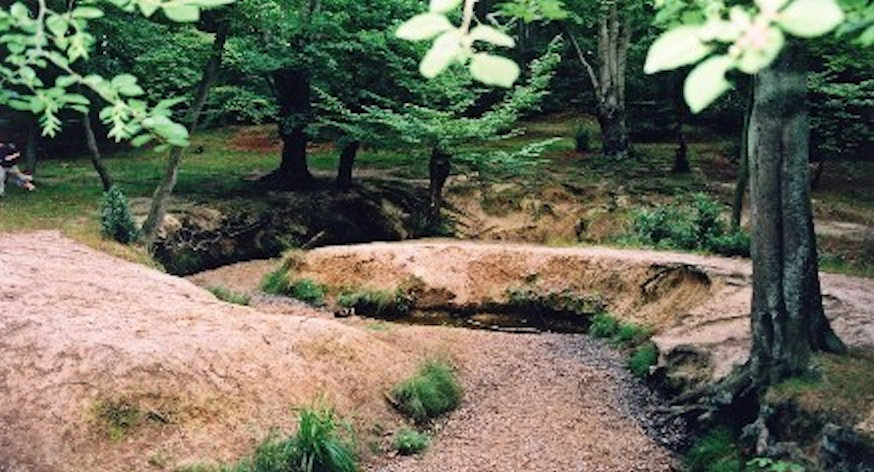The following sites have been selected to represent the different aspects of geology and landscape in the district. Not all sites have something to see; many are solely of historical interest as a record of an important or interesting discovery.
Some sites are not strictly geological but have a geological connection. Geological sites are therefore defined in their widest sense and include, for example, buildings, walls, wells, spas, springs, graves, boreholes, plaques, landslips and viewpoints.
This is not a complete list of geological sites in the district. Others will be added and descriptions expanded as further research is carried out.
Important note:
Not all of the sites here described are accessible. Some sites are on private land and can only be viewed from footpaths that pass through or alongside the site. Inclusion of a site on this list does not, therefore, imply any right of access. Please remember not to trespass on private land.
Sites of Special Scientific Interest (SSSIs)
No geological SSSIs have been notified in the district.
Local Geological Sites (LoGS)
EPPING FOREST. Loughton Brook Meanders (TQ 418 968)
Meanders are a common feature of lowland rivers but usually they are large making it difficult to appreciate them from ground level. Loughton Brook has a fine group of small-scale, slightly incised meanders which are easy to study and accessible to visitors. The site is in a woodland setting on the edge of Epping Forest within walking distance of Loughton town centre.
Other Sites
BEAUCHAMP RODING. Beauchamp Roding Sarsen Stone (TL 578 098)
On the top of the hill, in the churchyard of St. Botolph’s Church is an upright sarsen stone, 120 x 110 x 30 cm in size, with veins of flint pebbles running through it. Many superstitions are associated with this stone and it therefore has been cited in articles and books more often than any other sarsen in Essex.
BUCKHURST HILL. Lord’s Bushes (TQ 413 935)
The woodland sits on an extensive patch of Woodford Gravel, the origin of which is not entirely clear. The pebble assemblage indicates that it was deposited by a northward-flowing river flowing from what is now the Weald northwards across East London to join the Thames, which at that time flowed across north Essex and Suffolk. The gravel may be over 700,000 years ago. There are exposures of gravel in the banks of ponds. (Lord’s Bushes adjoins Knighton Wood which is in the London Borough of Waltham Forest).
CHIGWELL. Hainault Forest (TQ 478 938)
The site lies on the border with the London Borough of Redbridge. In 1951 a sand pit was said to exist at TQ 481 939, which is on the Essex side of the border. It was said to contain fine, buff-coloured Bagshot Sand with some narrow seams of pipe clay. The outcrops of pebble gravel, which cap the Bagshot Sand, are also on the Essex side of the border. Another (gravel?) pit was said to exist on Crabtree Hill nearby.
EPPING. Gernon Bushes Nature Reserve (Coopersale Common) (TL 4797 0297)
Disused gravel pits in woods. Essex Wildlife Trust Reserve. Some limited exposures of Pebble Gravel (Stanmore Gravel) at approx TL 4797 0297. Pebble gravel was deposited over a million years ago but its precise origin is unknown. The gravel contains a high proportion of brown clay, no doubt derived from the Claygate Beds.
EPPING. Wintry Wood Brick Pit (TL 469 035)
Disused brick pit in Wintry Wood adjacent to Brickfield Business Centre (formerly Wintry Park Brick & Tile Works). Steep banks with some Anglian Till (Chalky boulder clay) visible in tree roots. This pit is the only place in Essex on public land where direct evidence of the presence of an ice sheet can be seen. The pit is in the Lower Forest (part of Epping Forest). Layby for parking nearby.
EPPING FOREST. Blackweir Pond (TQ 423 978)
As the glaciers at the edge of the Anglian ice sheet slowly melted they dumped great quantities of glacial moraine, at their margins. These mounds are called kames, or more accurately kame terraces, and one of these is preserved as a patch of gravel nearly a kilometre long that follows the contour of the valley south of Great Monk Wood. Blackweir pond is one of the former gravel pits that worked this gravel. Blackweir Pond has been described as the most picturesque of all the Epping Forest ponds.
EPPING FOREST. Strawberry Hill Pond (TQ 414 965)
Former gravel pit now an attractive forest pond with steep banks of gravel in places. The gravel is thought to be the remains of a ‘kame terrace’ which is gravel laid down at the edge of a glacier that flowed around the high ground of the Epping forest ridge about 450,000 years ago (see also Blackweir Pond).
HIGH BEACH. High Beach Viewpoint (TQ 411 981)
The high ground around the King’s Oak inn is capped with ‘Pebble gravel’ (Stanmore Gravel) which may have been deposited by an unknown river that flowed north from the Weald of Kent to join the ancestral Thames (gravels of similar composition occur at the top of Shooters Hill on the south side of the Thames). Well-rounded pebbles from this gravel are revealed on the many footpaths hereabouts. Beneath the gravel is Bagshot Sand which is visible on the steeply-sloping paths to the north-west of the inn. Many similar high points exist such as Billericay, Havering-atte-Bower, the Langdon Hills and Warley.
MAGDALEN LAVER. Greens Farm Sarsen Stones (TL 504 074)
In the entrance drive to Greens Farm outside some houses are two sarsen stones lying flat on the grass. The largest is 1.3 metres in size.
MORETON. Bushes Farm Boulders (TL 525 079)
At Bushes Farm a large Hertfordshire puddingstone boulder (1.7 metres long) and a boulder of Carboniferous Limestone (1.1 metres long) lie by the road either side of the entrance drive.
NORTH WEALD BASSETT. Wyldingtree Sarsen Stones (TL 510 059)
At Wyldingtree Farmhouse are three sarsen stones (the largest 1.20 metres long), and a Hertfordshire puddingstone (80 cm long) on the roadside by the entrance. A fourth sarsen (1.8 metres long) is situated just inside the private garden.
THEYDON BOIS. Oak Hill Pit (TQ 4384 9933)
This former brickworks pit in Epping Forest forms a deep amphitheatre in the forest. The north face has a 7 metre high slope covered in beach trees. Claygate Beds with Bagshot Sand at the top of the face. A fine sand is exposed in the roots of fallen trees. The brickworks has an interesting history.
UPSHIRE. Upshire Stone (TL 424 016)
On the grass at the junction of two farm tracks near Lodge Farm, Copped Hall Green is a large sarsen stone (1.8 metres long). This is the largest erratic boulder in this part of Essex.
WALTHAM ABBEY. Cobbins Brook.
A stretch of about 7 kilometres of Cobbins Brook between Epping Upland and Waltham Abbey is notable because it has a largely natural appearance, with the kind of characteristic river features that have been lost from many watercourses in lowland England due to human interference such as channel straightening and bank re-profiling. These natural features include meanders, low cliffs and gravel bars. Private land. Access only with the permission of the relevant landowner.
WALTHAM ABBEY. Holyfield Puddingstone (TL 387 030)
In the hamlet of Holyfield is a Hertfordshire puddingstone 90 cm long on a triangle of grass in front of a cottage. This is the boulder that started E.A. Rudge on his life-long quest for evidence of an ancient ‘conglomerate trackway’ across southern England.

